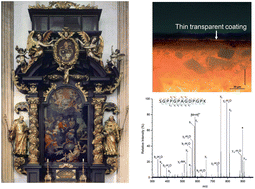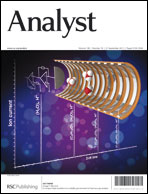Proteomics applied to the authentication of fish glue: application to a 17th century artwork sample†
Abstract
This work provides the first identification of fish glue from a few micrograms of a 17th century artwork sample using an adapted proteomics approach. Fish glue has been widely used as a binder in various art objects such as paintings, manuscripts or polychrome objects however its authentication remains particularly challenging. The lack of information on fish species in genomic and proteomic databases represents a major drawback. A supplementary difficulty is provided by the historical sample features, i.e. a few micrograms of a 17th century polychrome object with a multilayered structure. SYPRO® Ruby staining was used as a screening technique to probe the presence of proteins in the sample cross-section. Results revealed the presence of several layers containing proteins among which a thin proteinaceous layer located between the silver leaf and the glaze. This thin layer is described as fish glue coating by historical sources but its composition has not been identified yet. The optimized methodology, based on high resolution mass spectrometry and adapted bioinformatic tools, was successfully applied to 50 μg of a polychromy sample and resulted in the identification of several collagen proteins. Extensive interpretation of data generated by tandem mass spectrometry allowed the identification of proteins from different biological origins. In particular, seven peptides specific to fish collagen proteins were identified for the first time proving the presence of fish glue in the sample and corroborating information found in historical texts dealing with the polychromy technique.

- This article is part of the themed collection: Molecular Analysis for Art, Archaeometry and Conservation

 Please wait while we load your content...
Please wait while we load your content...